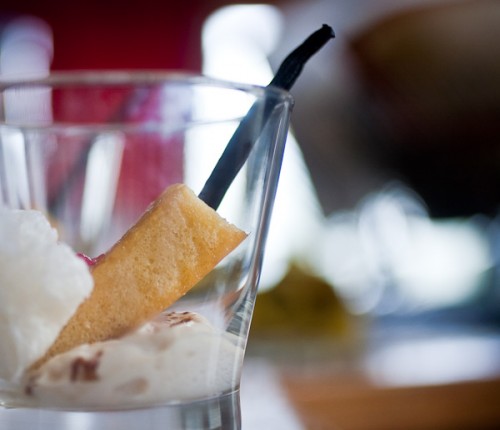
So. Bittersweetly, this will be the last dish I make from New Zealand, at least for a while. I’d like to think this is appropriate, because it’s also been the most cantankerous to accomplish from down here, and I admittedly just phoned bits of it in.
The plot: a small rectangle of sponge cake, sandwiched inside an outer shell of ‘something crispy’, with a fresh whole vanilla bean poked down the center, which turns the whole thing into a lollipop cake of sorts. It’s sitting in a clump of tonka bean foam and froth, and topped with tonka bean shavings and cherry powder.
I’ve never made sponge cake before, and we sold our power hand mixer last week. So, when the recipe told me to ‘mix some egg yolks with sugar and oil for 3 minutes, then fold in some flour’, I suspected that the act of folding meant that the act of whipping probably yielded something light, fluffy, and somewhat stiff. Doing this with a whisk by hand gave me popeye biceps and took up about a half hour of my time, while simultaneously giving me an appreciation for human ingenuity. I was then to pour the batter onto a half-sheet tray, ostensibly to a depth of about 1/2 inch. I don’t own a half-sheet tray, so in a pinch, I decided to make a silicon divider from one of the crappy spherical molds I had laying around from a previous recipe. I just shaved an angle off the ends of this mold, and voila:
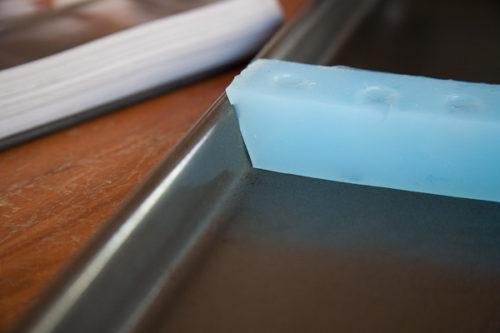
A half-sheet divider! I’m seriously debating contacting the chicago mold school and pimping this idea to them, because I’d buy the heck out of some real silicon sheet dividers.
One of the ingredients in the sponge cake was “Trimoline”. It took some googling to figure this one out; Trimoline is the brand-name of an invert sugar that’s commercially-available in some countries. NZ is not “some countries”. Rather than having the patience/fortitude to order a can of this stuff, I changed tack and searched around for substitutes. “Invert sugar” is simple sugar that has been broken into its separate components of fructose and sucrose. Invert sugar is less hygroscopic than normal sugar and resists crystallization. It is also apparently more-easily digested and sweeter in taste. Honey, then, is a suitable substitute for trimoline. In fact, honey is exactly an invert sugar, containing impurities that give it its flavor. I wondered if honey could be somehow filtered to yield just the invert sugar. Further searching led me to some beekeeping websites, where I learned that beekeepers often use invert sugar to feed bees in the early stages of a new hive, as it most-closely resembles honey and is easy for bees to digest. Several of these sites mentioned making one’s own invert sugar, which is exactly what I needed. Turns out that making your own invert sugar is a relatively-simple process: boil 2 parts water to 1 part sugar, add an acid of some sort (how much depends on the type of acid; I found people using cream of tartar, fresh lemon juice, and citric acid each in varying amounts). The acid breaks apart the sugar molecules; you want to boil for about 20 minutes to allow as much of the sugar as possible to separate. Most sites suggested boiling until the water goes clear, but not too long or too much of the water will evaporate and the sugar will caramelize.
This sounded totally awesome, and I really wanted to try it. But, limited time and a desire to serve this at a friend’s for easter led me to take a shortcut, and I just used some NZ Kamahi honey. This worked kinda ok; the sponge is moist and fluffy and spongy and delicious, but the flavor of honey completely overwhelms the subtle cherry flavors included in the recipe.
The ‘crispy outer shell’ around the sponge cake is ‘neutral caramel’, which basically involves making caramel, powdering it, then melting the powder into incredibly thin and delicate sheets of caramel glass:
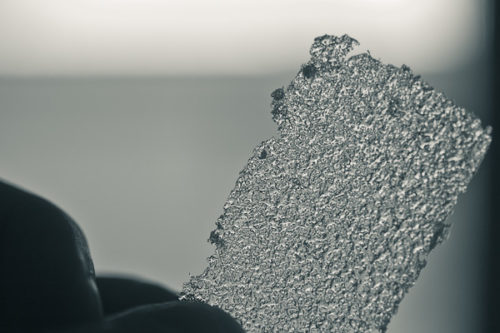
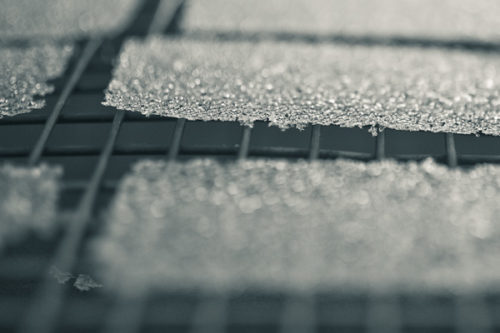
I didn’t expect it, but this took me two days to get right. Specifically, it was the actual making of the final glass sheets. The caramel melts very fast when heated as instructed, and if you let it cook too long, it beads up rather than just liquifying into a puddle. Once it beads, it’s worthless…you want it to JUST melt. Only then can you quickly cut it into the thin sheets that you need. Timing complications aside, our current house is a block from the beach, and wellington is notoriously humid. So, once I had the sheets made, I had to keep them dry. This ended in tears; Sunday is laundry day, so in addition to the normal moisture levels in this place, the running dryer causes condensation on the interior of our windows, which is indicative of how much water is in the air. The caramel glass melted/stuck to the wire mesh I had them cool on, and later to the silicon sheet I moved them to. I ended up with about half the amount I needed to plate the dish.
Last was the tonka bean froth and foam. The last time I made a dish with tonka beans, I just shortcut them and used a mixture of cloves, nutmeg, and cinnamon (after reading what tonka beans are on Wikipedia). I did this knowing nothing about the target I was aiming for. This time around, though, I thought I’d bite the bullet. Against the concept of “better judgement” as a whole, I went ahead and ordered a small ($25) bag of tonka beans (shipping: $35). They’re unavailable in NZ as far as I know, but can be found on a few US sites. Excitingly, I discovered that tonka beans are not on MAF’s list of approved importable items, so a few days after I ordered them I got a letter from MAF advising me that the beans needed to be ‘heat treated’ or face destruction. Awesome. After calling a few pest control services, I found one that offered a heat treatment of 85 degrees for 15 hours at $16 for the service. “Huh,” I thought, “that’s not so hot. Surely these delicate, fragrant beans will be fine. It wasn’t until the next day that I realized that “85 degrees” probably meant “85 degrees celsius”. Damn my American tendencies; what at first seemed akin to a warm summer day quickly changed to dread that my too-expensive beans would arrive shriveled and burnt to a crisp.
Was I wrong? Well, I don’t know. The beans arrived incredibly fragrant, with some peeling shell-like skin on them which I don’t know whether it was included with the shipment or formed as a product of the fumigation. But they smelled amazing. Like their description says, they have scents of cinnamon, clove, nutmeg, some anise…but none of these flavors are fully-realized. Rather, they’re just hinted at in the aroma of the beans sort of abstract and fleeting. I think this must be the magic of these beans, and I immediately appreciated them.
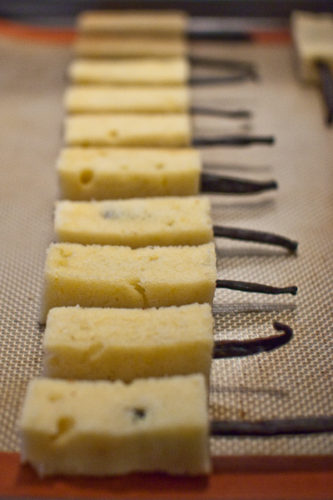
After doing the best I could at assembling the lot, I took the components over to my friend Dan’s for an Easter dinner. Putting it all together garnered a bit of an audience, and the few good caramel glass sheets I had salvaged melted pretty quickly from the transportation. I plated two of these for Sarah and myself before leaving, so I understood their purpose and what they contributed, but was sad not to be able to share them too adeptly with everyone else.
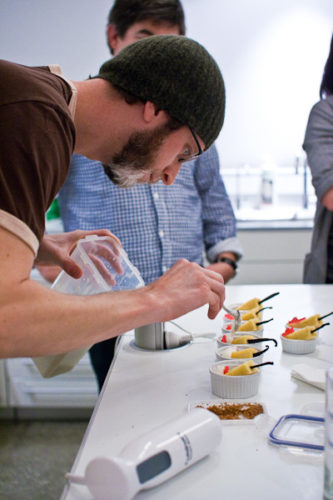
But my friends are awesome, and shared my fascination with assembling everything. Oh, I almost forgot: I ordered a nice big tub of freeze-dried cherries to make cherry powder for these about a year ago. When I opened the tub to get some cherries out for this recipe, I found that the humidity here had caused the entire tub to fuse into one big, moist brick of cherry bits that was completely worthless. So I substituted diced maraschino cherries. I can’t say I’m too proud of this; I cut corners right and left. It was still quite delicious; I really am amazed by the tonka beans, which are the hero ingredient here. But my heart was distracted during making this one, so it was less-satisfying than these dishes usually are.
It still managed to pass muster with one of my toughest critics though:

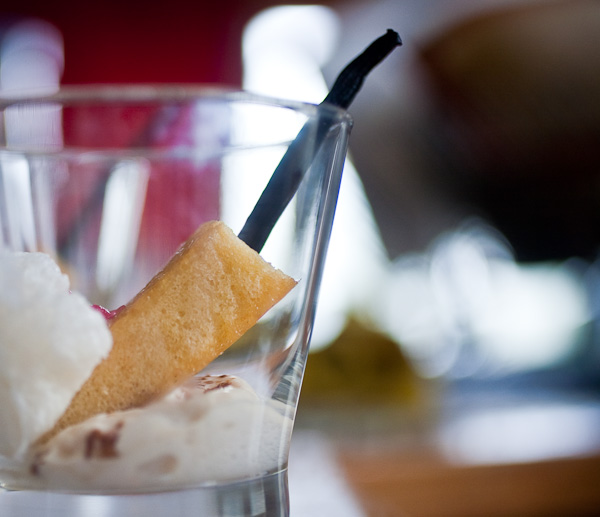
Very nicely done as always, this is one I have wanted to try as well but havent gotten around to ordering the trimoline, tonka beans and freeze dried cherries.
Thank you so much for posting this! I am searching around the web for tonka and cherry recipes to compliment a cocktail I am working on for a competition. I came across your site and this is perfect! Now I know what to do to get my hands on some tonka!! Just wondering if you could tell me where you for your freeze dried cherries from?
Thanks 🙂
Hi Jamie, I found Freeze-dried cherries, in this case, from Chef Rubber online. Though you might also find them via amazon, or from Just Tomatoes, who sell a variety of freeze-dried fruits and vegetables (often in much smaller quantities than that of Chef Rubber). Good luck!
Hi Allen,
So I think I might have managed to find some freeze dried cherries from a NZ supplier. Tonka however ended up being the real challenge. Could you please tell me what website did you buy them off?
Thank you 🙂
Hi Jamie;
Sure, I bought them here:
http://www.scents-of-earth.com/tonka.html
If you’re trying to buy these from NZ, note that customs could require you fumigate them on entry to the country (this is what happened to me); they sent me info about this, and I think I chose the cheapest option (basically you have to contact a 3rd party fumigator to handle this). The fumigation consists of heat-treating for a few days. It took about a week, and what I ended up with seemed to me to be in good order.
Cheers!
–a